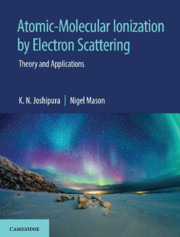Book contents
- Frontmatter
- Dedication
- Contents
- List of Figures
- List of Tables
- Foreword I
- Foreword II
- Preface
- Acknowledgments
- 1 Atoms and Molecules as Bound Quantum Systems
- 2 Quantum Scattering Theories
- 3 Electron Atom Scattering and Ionization
- 4 Electron Molecule Scattering and Ionization – I: Small Molecules and Radicals
- 5 Electron Molecule Scattering and Ionization – II: Other Polyatomic Molecules and Radicals
- 6 Applications of Electron Scattering
- Bibliography
- Index
6 - Applications of Electron Scattering
Published online by Cambridge University Press: 20 December 2018
- Frontmatter
- Dedication
- Contents
- List of Figures
- List of Tables
- Foreword I
- Foreword II
- Preface
- Acknowledgments
- 1 Atoms and Molecules as Bound Quantum Systems
- 2 Quantum Scattering Theories
- 3 Electron Atom Scattering and Ionization
- 4 Electron Molecule Scattering and Ionization – I: Small Molecules and Radicals
- 5 Electron Molecule Scattering and Ionization – II: Other Polyatomic Molecules and Radicals
- 6 Applications of Electron Scattering
- Bibliography
- Index
Summary
The previous chapters have highlighted electron induced processes taking place with a wide variety of atoms and molecules, at incident energies from ionization threshold (∼15 eV) to about 2000 eV. These studies seek to provide fundamental knowledge and develop insights into these processes that enable us to interpret the relevant phenomena occurring in both natural and technological environments. In this chapter we aim to highlight various applications of such electron scattering data from different atomic–molecular targets. Electrons are almost everywhere in the universe and provide one of the simplest probes for exploring matter in its different forms. Electron collisions with atoms, molecules and ions are dominant in many of the naturally occurring phenomena including the Earth's atmosphere and in the atmospheres of other planets and their satellites, in comets and in far-off molecular clouds of the interstellar medium, where they may play a key role in producing the molecular precursors of life. Primarily the ionosphere of the Earth and other planets is formed by ionization produced by solar UV and X-rays, with some of the photoelectrons produced being energetic enough to cause further ionization along with excitation, leading to the magnificent phenomena of the aurora. The solar wind contains not only electrons (average energy ∼12 eV) but protons and other charged particles which produce secondary electrons upon interaction with our upper atmosphere. Furthermore relativistic electrons, though in lower concentrations, are continuously arriving on the Earth as a part of cosmic rays coming from far-off galaxies, etc.
Thus the upper atmospheres of the Earth and planets are a veritable electron collision laboratory in nature. Cross sections for interaction processes of electrons are therefore necessary inputs into the models for understanding physico-chemical and dynamic properties of atmospheres/ionospheres of the Earth and other planets as discussed by Haider et al. (2010, 2012) and others. Energy degradation of electrons resulting from ionization and other inelastic processes in specific atmospheres can be investigated by employing Monte Carlo models as demonstrated in Bhardwaj and Mukundan (2015), and references therein.
Electron scattering discussed in the previous chapters is basically a microscopic, i.e.
- Type
- Chapter
- Information
- Atomic-Molecular Ionization by Electron ScatteringTheory and Applications, pp. 177 - 218Publisher: Cambridge University PressPrint publication year: 2019



